Creators of the just-launched ReuseWood.org are knocking on the hard stuff that their new collaborative website will help capture more of the U.S. Environmental Protection Agency (EPA)’s reported 1 billion feet of usable lumber generated from demolished buildings each year.
Behind the virtual curtain of this effort are three organizations–the American Wood Council (AWC) and Canadian Wood Council (CWC) and the Building Materials Reuse Association (BMRA)–which have joined forces to develop an online North American directory highlighting reuse and recycling options for wood and wood products.
The goal of the resource-driven website, which just launched, is to serve as connection between vendors and customers who are looking to either recycle their used wood products or sustainably source materials for a reclaimed project.
"There has historically been a lack of awareness of the opportunities to recycle and reuse wood products, and thereby extend their useful life. We are aiming to change that," said Robert Glowinski, AWC president and CEO. "Our industry wants to do its part when it comes to the full life-cycle impact of our products. It's our hope that this directory will help educate builders, designers and consumers on the many opportunities to salvage, recycle or reuse wood products, in turn reducing waste."
We grabbed a few minutes with Glowinski to discuss the need for this website and the new features and capabilities of ReuseWood.org.
Waste360: Tell us a little bit about the AWC and its mission.
 Robert Glowinski: The American Wood Council (AWC) is the voice of North American wood products manufacturing, representing over 75 percent of an industry that provides approximately 400,000 men and women in the United States with family-wage jobs. AWC members make products that are essential to everyday life from a renewable resource that absorbs and sequesters carbon. Staff experts develop state-of-the-art engineering data, technology and standards for wood products to assure their safe and efficient design, as well as provide information on wood design, green building and environmental regulations. AWC also advocates for balanced government policies that affect wood products.
Robert Glowinski: The American Wood Council (AWC) is the voice of North American wood products manufacturing, representing over 75 percent of an industry that provides approximately 400,000 men and women in the United States with family-wage jobs. AWC members make products that are essential to everyday life from a renewable resource that absorbs and sequesters carbon. Staff experts develop state-of-the-art engineering data, technology and standards for wood products to assure their safe and efficient design, as well as provide information on wood design, green building and environmental regulations. AWC also advocates for balanced government policies that affect wood products.
Waste360: What was the impetus to develop the new website, and why was it necessary to create it?
Robert Glowinski: Reclaimed wood products represent a largely untapped and valuable resource for sustainable construction. The website serves to connect vendors and customers who are looking to either appropriately recycle their used wood products or sustainably source reclaimed materials for a project. For example, a building deconstruction team might use the website to identify and contact a nearby recycling vendor in order to responsibly dispose of their used wood products. Or, a builder hoping to find locally recycled wood for acoustic use in the atrium of a building can use the Directory to find a specific wood products reuse dealer in their area.
The website is designed as a directory of wood reuse and recycling resources in the United States and Canada to serve consumers, developers, architects, builders, state and municipal sustainability departments, along with recycling and waste collection companies.
Waste360: What are some of the unique features and capabilities of the site?
Robert Glowinski: The Reuse Wood website is unique because it serves several purposes related to the recycling and reuse of wood products. The three primary features and capabilities of the website include:
An interactive business directory accessible via map and list, with easy sorting capabilities according to target categories (location, services provided, etc). The map function will use a visitor’s current location to show nearby businesses either accepting wood products to be reused or recycled, or locations where builders and consumers can find reusable and recycled wood products for their own use.
Individual listing pages with the contact information, location and available services for each business. Listings also include a button for a company to claim their own listing, and for users to indicate if the information is incorrect or out of date.
A sustainable wood guide provides a number of articles on the different wood products and the opportunities for wood reuse or recycling. These articles include objective information, potential options for the reuse of wood products and citations for additional resources.

Waste360: Do you have a favorite feature?
Robert Glowinski: My favorite feature is the ability for building designers to source reclaimed wood from vendors in their area for use in new projects. While the directory serves many purposes, there is a huge opportunity for architects to use reclaimed wood and consequently reduce the environmental impact of their buildings. Wood products have less embodied energy, are responsible for lower air and water pollution, and have a lighter carbon footprint than other commonly used building materials. And by salvaging wood products we lesson the impacts associated with extracting and processing resources.
Waste360: How big of an undertaking was creating the site?
Robert Glowinski: The creation of this website was a joint undertaking between the American Wood Council, Canadian Wood Council and Building Materials Reuse Association (BMRA). After several industry discussions, we realized there was an opportunity to educate the public about the options of the reuse and recycling of wood products. Research General Engineer Robert Falk from the USDA (U.S. Department of Agriculture) Forest Products Laboratory put us in touch with the BMRA, which had a reuse directory, and we collectively saw the possibilities in further developing that into an interactive website to include both reuse and recycling. Our partnership evolved from that.
The site was developed over the course of about a year and modeled after other recycling and reuse sites with which BMRA had previously worked on or had familiarity.
The industry historically has had a strong interest in creating a new relationship between suppliers and customers at the sector level to provide joint solutions in the recycling and reuse of wood products. This website reflects our goal of improving recycling opportunities and ensuring the continued growth of the reclaimed wood market, while helping keep building materials out of landfills.
Waste360: What is your hope moving forward with the site? How do you expect it to change and develop over time?
Robert Glowinski: Our hope is that customers and suppliers use this website, and that it helps to reduce the impact of the built environment. Organizations involved in wood recycling and reuse are encouraged to enter information in our Business Directory if they are not already listed, or to claim their listing. Ideally, organizations across North America will continue to share information, allowing for more local resources to customers and resulting in an increase in the recycling of wood products.
About the Author(s)
You May Also Like


